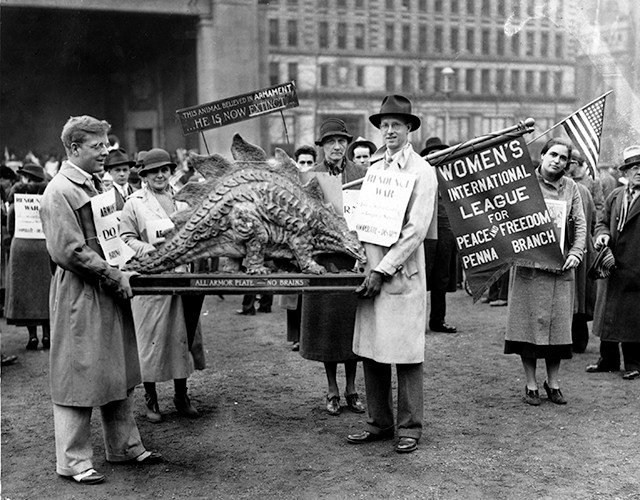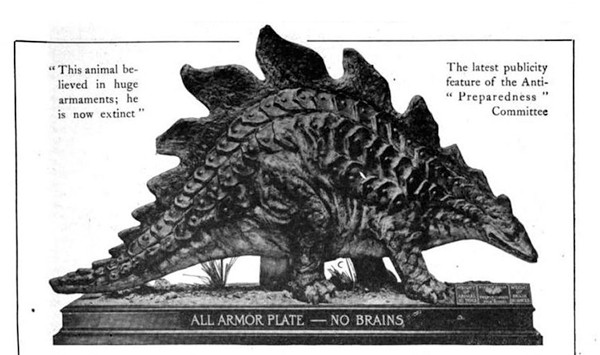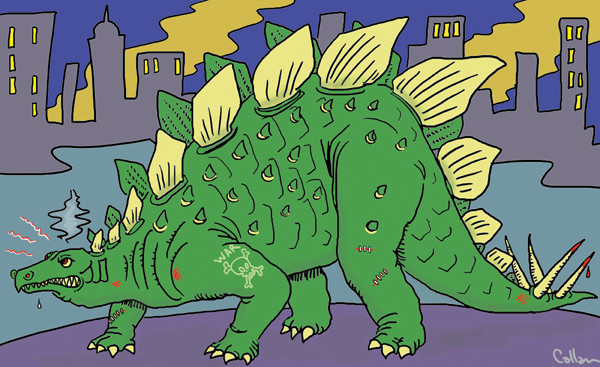
by David B. Williams Wednesday, September 23, 2015

In March 1935, a smaller model of the original Jingo was used to protest a speech in Philadelphia, Pa., by U.S. Secretary of War George Henry Dern in which he called for increased military spending. Credit: Peace Collection/Swarthmore.
David B. Williams
One side effect of the discovery and popularization of dinosaurs in the latter half of the 19th century was their introduction into the vernacular as a metaphor, particularly concerning international politics and war. For example, just prior to World War I, one writer compared Russia to Diplodocus, “a vast inert creature,” only saved from extinction because of English expansionists. To French paleontologist Pierre Marcellin Boule, however, Diplodocus provided a more dangerous comparison, at least in reference to Germany: “an overgrown brute, specialized in strength, mad with its own might.”
In contrast, H. G. Wells compared his own country to Brontosaurus and Atlantosaurus. The British Empire “sacrifices intellect to character; its backbone…is bigger than its cranium … while the clumsy monster’s fate, all teeth and brains, crept nearer and nearer.” The only way to shake England out of its saurian “lethargy of soul,” Wells wrote, was war. Wells’ metaphor appeared in his novel “The New Machiavelli,” first serialized in 1910 and published in 1911.

Jingo, a 4.5-meter-long model Stegosaurus fashioned out of papiermâché, was part of a 1916 campaign by the American Union Against Militarism protesting U.S. armament during World War I. Credit: Survey Magazine, April 1916.
It was during the Great War, though, that the dinosaur metaphor took on a new manifestation, not just on paper but in the flesh, so to speak. On April 4, 1916, “Jingo the Stegosaurus” made his first appearance. Named after “jingoism,” a term coined in 1870s Britain to describe aggressively nationalistic stances on foreign policy, and fashioned out of papier-mâché, the 4.5-meter-long model rode around New York City on a cart pulled by a horse named Needles. Supporters traveling with Jingo carried signs that read “This is Jingo — The Armored Dinosaur. All Armor Plate and No Brains! This Animal Believed in Huge Armament. He is Now Extinct!”
Jingo’s travels in New York were a publicity stunt thought up by the Anti-Preparedness Committee (APC). The APC soon changed its name to the American Union Against Militarism (AUAM), for which it became better known. The AUAM had started as a response to calls to build up the American military in the event that the United States became involved in the war.
To the AUAM, Jingo exemplified the pitfalls of militarism. “What could be more like the heavy, stumbling, clumsy brutal foolery which is destroying Europe than those old monsters of the past, the armored dinosaurs? These beasts, all armor-plate and no brains, had no more intelligent way of living than that of ‘adequate preparedness.’ All their difficulties were to be met by piling on more and more armor, until at last they sank by their own clumsy weight into the marsh lands,” wrote Walter Fuller in The Survey, a leading magazine of social reform. He had come up with the idea of Jingo after seeing a Stegosaurus on display in the Smithsonian.
Preparedness was one of the most fiercely debated issues before the war. President Woodrow Wilson, who initially favored peace and isolation, eventually reversed his position, due in part to the sinking of the Lusitania by a German U-boat in May 1915, which killed nearly 1,200 people, including more than 100 Americans. Nine months later, Wilson set forth on a nine-city speaking tour to rally support for the “preparation of her citizens to take care of themselves,” as he said in his opening speech in New York City. The tour focused mostly on the Midwest, with stops in Topeka, Kan., Des Moines, Iowa, Kansas City, Mo., and elsewhere.
Wilson’s final speech was in St. Louis where, for the first time, he addressed those who opposed his suggestions. Calling their attitude “hopelessly and contentedly provincial,” he urged the anti-preparedness crowd to rent large halls, attempt to fill them and air their concerns. Doing so was the simplest way to expose the “folly” of their ideas, he said, a line that brought applause and laughter.
Taking Wilson’s jeering suggestion to heart, the AUAM decided to rent halls in many of the cities where the president had spoken. New York’s Carnegie Hall was the first stop. Jingo then hit the road, arriving two days before each scheduled visit by AUAM’s speakers.

The model Stegosaurus was named for "jingoism," a term coined in 1870s Britain to describe aggressively nationalistic stances on foreign policy, and purportedly represented the idea that armament leads to extinction. Credit: ©Callan Bentley, 2013.
Othniel Charles Marsh first described Stegosaurus in late 1877, based on bones found by Arthur Lakes and Henry Beckwith. They had unearthed the fossils in Jurassic sandstone near Morrison, Colo. Included in the collection were vertebrae, teeth, the shaft of a femur, and part of a dermal plate, but none of the Stegosaurus’s famous tail spikes. Marsh initially proposed that Stegosaurus was an aquatic animal with a turtle-like body encased in plates. Additional discoveries led him to a description of a well-armed, bipedal animal, “by far the strangest appearance of all the Dinosaurs yet discovered.”
Stegosaurus may have been able to defend itself with formidable tail spikes but whether it had the intelligence to do so was another question. Marsh reported that the dinosaur had the “smallest brain of any known land invertebrate,” even smaller than Morosaurus, or the “stupid dinosaur,” which he had named previously. But Stegosaurus also had a “posterior brain-case,” wrote Marsh. He did not know its purpose but suggested that the “posterior part was dominant.”
Other scientists weren’t immune from characterizing Stegosaurus as dim either. Edwin Sharpe Grew, author of the book “Romance of Modern Geology,” described the great beast as “a creature depending on his ugliness and armour for protection.” To Yale paleontologist Charles Schuchert, Stegosaurus was “superlatively stupid,” the “embodiment of the death agony of a race.” It was thought that its small brain had surely contributed to its extinction.
With such a reputation, Stegosaurus was an ideal vehicle for the AUAM to use to poke fun at and satirize the preparedness movement. Jingo would also bring “a touch of humor and ancient intrepidity into this season of overwrought nerves,” according to an editorial in The Survey.
From New York City, Jingo headed north to Buffalo, N.Y., before traveling to the Midwest, mostly following President Wilson’s tour with stops from Chicago to Kansas City, Mo., to Cincinnati. He made his final appearance in Pittsburgh on April 16. In modern terms, Jingo’s travels went viral, garnering widespread newspaper coverage. Most papers described him as a “15-foot-long” model, but the Aberdeen American in South Dakota stretched him out to “50 feet.” He merited a photograph and an editorial in the Seattle Times, and he was front page fodder for newspapers from Juneau, Alaska, to Biloxi, Miss., where he had to compete with stories about drowned pigs and bootleg whiskey.
Accompanying Jingo was a cadre of socialists, pacifists, suffragists, labor leaders and congressional representatives. At each stop they gave impassioned speeches in which they warned of the costs of the military buildup; questioned who would profit from the war; and counseled that instead of preparing for battle, America should prepare to help our allies who were at war, but not enter into battle ourselves. “When I learn that the price we must pay for the security of our republic is the abandonment of every ideal that makes this republic, I for one refuse to pay,” said Unitarian minister John Haynes Holmes, who had helped found the NAACP and would later do the same with the American Civil Liberties Union.
Not everyone appreciated Jingo. A Buffalo newspaper proffered that the Almighty had given Stegosaurus his ponderous protection and, thus, the AUAM shouldn’t question that divine decision. Most critics warned, though, that the pacifists’ heads were in the sand. America needed to be ready to fight. We need the “acquisition of weapons which will not burden the nation’s ordinary life but which will make it able to resist the saber-toothed tiger of aggression and the cave-bear of injustice,” wrote the editors of the State in Columbia, S.C.
Many also took the AUAM to task for its science. (The AUAM was clearly not a group of scientists; its propaganda included a line about anthropologists digging up the original Stegosaurus.) Consider the unarmed jellyfish, one editorial proposed. They survive, while other “soft” animals, such as the dodo — always a favorite example of extinction — did not. Or what about saber-toothed tigers with their huge teeth and relatively big brains? They, too, went the way of the Stegosaurus.
Nearly all of the editorials against Jingo came from the popular press, but at least one scientist decided to weigh in. Vertebrate paleontologist William D. Matthew, curator at the American Museum of Natural History (AMNH), wrote a long letter to the New York Times soon after Jingo appeared in the city. Although pleased that the efforts of his museum had made dinosaurs popular enough to be used in public propaganda, he thought Jingo was not a good choice. Three types of “peaceful vegetarian” dinosaurs had evolved: armored ones such as Stegosaurus, gigantic water-dwellers such as Brontosaurus, and “little fellows” that ran away when threatened, he wrote. Of the three, the armored ones had done best, surviving and prospering far longer than their cousins had. At the same time, big carnivores — including the Tyrannosaurus, which the AMNH had just put on display — thrived and led to the evolution of even more elaborate armor.
In the end, however, they all suffered the same fate of going extinct. “Why they disappeared I do not certainly know — probably bigness had something to do with it; probably lack of brains had more. But obviously the dinosaurs did not become extinct because of their armor,” concluded Matthew.
Despite the varied publicity, Jingo’s tour resulted in some success for the AUAM. In late April, President Wilson agreed to meet with a delegation from the group in the White House, and on May 8, about a dozen AUAM members met for more than an hour with the president. They used all of the arguments they had tried on the road, although Jingo did not come up during the conversation. Wilson listened respectfully but was clearly not supportive. Less than a year later, the U.S. declared war on Germany.
© 2008-2021. All rights reserved. Any copying, redistribution or retransmission of any of the contents of this service without the expressed written permission of the American Geosciences Institute is expressly prohibited. Click here for all copyright requests.